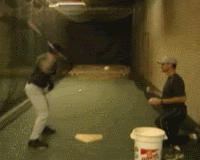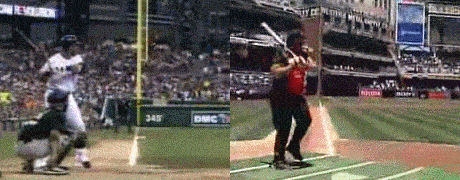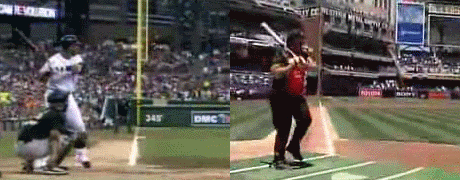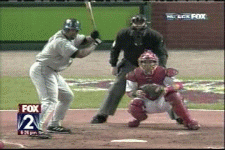Originally posted by tom.guerry:
JJA-
Changing the subject again. You have no other alternative.
Handle torque exists at the mechanical level in mlb pattern swings.
N$$an's model shows how this force can quicken the swing.
Without handle torque there is no early batspeed, nor is there a control mechanism for late adjustment/plane matching.
Frame counting is not useful unless you know first you are comparing apples to apples, that is, counting frames comparing hitters who are already sorted into pattern, mlb or non mlb (such as "PCR").
Once sorted into pattern, landmarks can be identified consistently enough to apply some frame counting, BUT in any case whether or not the hitter has an MLB pattern swing is FAR more important than frame counting.
You should learn to recognize the pattern which bluedog is trying to explain to you.
No amount of swing quickening can enable a PCR swing to work in MLB. MLB requires early batspeed and late adjustment. Batspeed alone or trying to calculate percentage of batspeed due to torque is a waste of time. As Mankin says (below) you need quick acceleration around the entire swing plane, beginning with rearward acceleration.
PCR hitters who adhere to the PCR guideline that says torque does not exist in the swing are FORCED into a non mlb pattern which lacks early batspeed and can not be effective no matter how short you make the swing in terms of frame count. This is why PCR or "PCRW" is always OBSESSED with bat drag. There is no other alternative if you adhere to the guidelines.
How you conceptualize the pattern/goal at the mechanical level can have a big influence on how you communicate for teaching as Mankin's points out here:
http://www.batspeed.com/messageboard/14865.html-----------
"When practicing your swing, it is important to keep in mind that the purpose of swing mechanics is not to get the hips to rotate ahead of the hands and shoulders, or even to take the hands to the zone. The ultimate purpose of all swing mechanics is to attain maximum acceleration of the bat-head around the 'entire' swing plane.
"With this in mind, when setting up your practice program, I would suggest that one of the most limiting factors to a hitter’s development is his tendency to only concentrates on those mechanics that swing the bat-head forward toward the ball. However, in a high level swing, before the bat-head arcs forward toward the ball, it must first be accelerated rearward from its launch position behind the head back to the lag position (first 90 degrees of acceleration).
"Therefore, as you prepare to initiate your swing, I would suggest you envision mechanics that would accelerate the bat-head around the entire 180+ degrees to contact -- instead of just concentrating on mechanics that accelerate the bat forward the last 90 degrees (from the lag position).
"As a hitter initiates the swing, it is very tough to keep his hands back when he is concentrating on swinging the bat-head forward. If a coach would have the hitter envision the bat-head first accelerating back toward the catcher at initiation, the batters hands would have to stay back to accelerate the bat-head in that direction.
"When we ask the body to perform an athletic movement, the sub-conscious mind will set up a motor program for the rest of the body to aid in accomplishing the task.
"Therefore, I have found that if I can get the batter to correctly envision the bat-head first accelerating rearward to the lag position before he directs his energy toward the ball, the more likely he will generate the most productive hip and shoulder rotation to accomplish the task.
"If, on the other hand, the batter’s vision of the swing is only forward, he will have the tendency to first extend the hands. This is mainly accomplished by using the arms to thrust the hands and knob, which does not require good hip and shoulder rotation. With this vision of the swing, keeping the hands back is at odds with his forward vision. He now has to consciously think, “Hips First.” -- Using cues to override a batter’s natural tendency to think forward is not as effective as changing how they invision the swing.
"Once I feel the batter is starting to have the correct vision of the swing, I use the cue, “Rotate the heel (initiate lower-body rotation) – Rotate the bat-head (initiate the acceleration back toward the catcher”). I ask the student, “what must you do with the top-hand as your elbow lowers to accelerate the bat-head back at the catcher?” After a few attempts, they learn to hold back (or pull back) the top-hand at the shoulder and allow shoulder rotation to accelerate the bat-head back. When they start to get the bat to accelerate correctly, the hips just naturally rotate ahead of the hands and they have the “L” in the back-leg at contact."
Jack Mankin
----------





